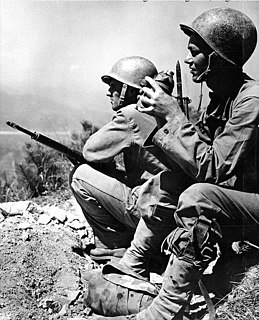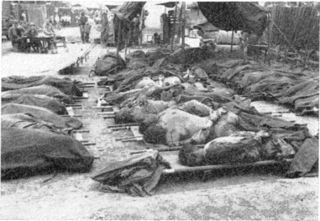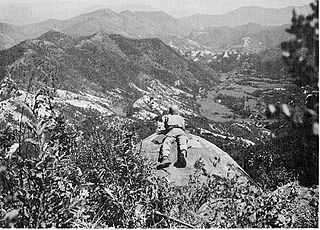Related Research Articles

The 1st Provisional Marine Brigade was a Marine infantry brigade of the United States Marine Corps (USMC) that existed periodically from 1912 to 1950. It was an ad hoc unit formed for specific operations and not considered a "permanent" USMC unit.

The Battle of the Pusan Perimeter was a large-scale battle between United Nations Command (UN) and North Korean forces lasting from August 4 to September 18, 1950. It was one of the first major engagements of the Korean War. An army of 140,000 UN troops, having been pushed to the brink of defeat, were rallied to make a final stand against the invading Korean People's Army (KPA), 98,000 men strong.

Lieutenant General Hobart Raymond Gay, nicknamed "Hap", was a United States Army officer who served in numerous conflicts, including World War II, where he worked closely alongside General George S. Patton, and later in the Korean War, where he commanded the 1st Cavalry Division.

Ernest Richard Kouma was a soldier in the United States Army during World War II and the Korean War. He rose to the rank of master sergeant and received the Medal of Honor for his actions on August 31 and September 1, 1950, during the Second Battle of Naktong Bulge in South Korea.
The 105th Guards Seoul Ryu Kyong-Su Armored Division is a military formation of the Korean People's Army. It was North Korea's first armored unit and took part with T-34-85 tanks in the Korean War.
The 124th Division was a division of the PRC People's Liberation Army. During the Korean War, it was the first unit of the People's Republic of China to cross the Yalu River.
The 198th Division(Chinese: 第198师) was created in February 1949 under the Regulation of the Redesignations of All Organizations and Units of the Army, issued by Central Military Commission on November 1, 1948, basing on the 3rd Brigade, 1st Column, 3rd Army Group of Huabei Military Region. Its origin could be traced to 4th Independent Brigade of Jicha Military District formed in June 1946.
This is the order of battle for United Nations and North Korean forces during the Battle of Pusan Perimeter in August and September 1950 during the Korean War. The engagement brought each side to muster substantial ground, air and sea resources to fight across southeastern Korea.

The First Battle of Naktong Bulge was an engagement between United Nations Command (UN) and North Korean forces early in the Korean War from August 5–19, 1950 in the vicinity of Yongsan and the Naktong River in South Korea. It was a part of the Battle of Pusan Perimeter, and was one of several large engagements fought simultaneously. The battle ended in a victory for the UN after large numbers of US reinforcements destroyed an attacking North Korean division.

The Battle of Taegu was an engagement between United Nations Command (UN) and North Korean forces early in the Korean War, with fighting continuing from August 5–20, 1950 around the city of Taegu, South Korea. It was a part of the Battle of Pusan Perimeter, and was one of several large engagements fought simultaneously. The battle ended in a victory for the UN after their forces were able to drive off an offensive by Korean People's Army (KPA) divisions attempting to cross the Naktong River and assault the city.

The Hill 303 massacre was a war crime that took place during the opening days of the Korean War on August 17, 1950, on a hill above Waegwan, South Korea. Forty-one United States Army (US) prisoners of war were murdered by troops of the North Korean People's Army (NKPA) during one of the numerous smaller engagements of the Battle of Pusan Perimeter.

In the Battle of the Bowling Alley , United Nations Command (UN) forces defeated North Korean forces early in the Korean War near the city of Taegu, South Korea. The battle took place in a narrow valley, dubbed the "Bowling Alley", which was north of Taegu. It followed a week of fighting between the Korean People's Army (KPA) 13th Division and the Republic of Korea Army's (ROK) 1st Division along the latter's last defensible line in the hills north of the city. Reinforcements, including the US Army's 27th and 23rd Infantry Regiments were committed to bolster the ROK defenses. This battle and several others were smaller engagements of the Battle of Pusan Perimeter.

The Battle of Masan was an engagement between United Nations Command (UN) and North Korean forces, which took place early in the Korean War between August 5 and September 19, 1950, in the vicinity of Masan and the Naktong River in South Korea. It was part of the Battle of Pusan Perimeter, and was one of several large engagements fought simultaneously. The battle ended in a victory for the UN after large numbers of United States Army (US) troops were able to repel the repeated attacks of two Korean People's Army (KPA) divisions.

The Battle of Nam River was an engagement between the United Nations Command (UN) and North Korean forces early in the Korean War from August 31 to September 19, 1950, in the vicinity of the Nam River and the Naktong River in South Korea. It was a part of the Battle of Pusan Perimeter, and was one of several large engagements fought simultaneously. The battle ended in a victory for the United Nations after large numbers of United States Army (US) troops were able to repel a Korean People's Army (KPA) attack across the river.
Lee Kwon-mu, also known as Yi Kwon-mu or Ri Gwon-mu (1914–1986?), was a North Korean People's Army general officer during the Korean War. He commanded a division, and later a corps, on the front line of the conflict and received North Korea's two highest military honours, the Hero of the Republic and the Order of the National Flag, First Class.
I Corps is a corps of the Korean People's Army Ground Force. It is headquartered at Hoeyang-up, Hoeyang County,

The Battle of Tabu-dong was an engagement between United Nations Command (UN) and North Korean forces early in the Korean War from September 1 to September 18, 1950, in the vicinity of Tabu-dong, north of Taegu in South Korea. It was a part of the Battle of Pusan Perimeter, and was one of several large engagements fought simultaneously. The battle ended in a victory for the UN after large numbers of United States Army (US) and Republic of Korea Army (ROK) troops repelled a strong Korean People's Army (KPA) attack.

The Second Battle of Naktong Bulge was an engagement between United Nations Command (UN) and North Korean forces early in the Korean War from September 1 to September 15, 1950, along the Naktong River in South Korea. It was a part of the Battle of Pusan Perimeter, and was one of several large engagements fought simultaneously. The battle ended in a victory for the United Nations after large numbers of United States Army (US) troops repelled a strong Korean People's Army (KPA) attack.

The Battle of Yongsan was an engagement between United Nations Command (UN) and North Korean forces early in the Korean War from September 1–5, 1950, at Yongsan in South Korea. It was part of the Battle of Pusan Perimeter and was one of several large engagements fought simultaneously. The battle ended in a victory for the UN after large numbers of United States Army (US) repelled a strong Korean People's Army (KPA) attack.
The Bloody Gulch massacre was a war crime that took place in the Korean War on August 12, 1950, in "Bloody Gulch", west of Masan, South Korea. After a very successful attack on two undefended US artillery battalions that killed or injured hundreds of US soldiers, members of North Korea's Korean People's Army (KPA) 13th Regiment murdered seventy-five captured US Army prisoners of war during one of the smaller engagements of the Battle of Pusan Perimeter. The murdered soldiers were from the 555th Field Artillery Battalion of the US 24th Infantry Division and the 90th Field Artillery Battalion of the US 25th Infantry Division.
References
- ↑ Disaster in Korea: The Chinese Confront MacArthur. Roy E. Appleman. November 2008. ISBN 9781603441285 . Retrieved June 6, 2016.
- ↑ "Loyal Haynes". The Hall of Valor Project. Retrieved August 20, 2018.
- ↑ "Alpine Rescue". Life Magazine. 1946-12-09. Retrieved August 20, 2018.
- ↑ "SOUTH TO THE NAKTONG, NORTH TO THE YALU". Roy E. Appleman. Retrieved August 20, 2018.
- ↑ "Knox College Catalog". Knox College. 1916. Retrieved June 6, 2016.